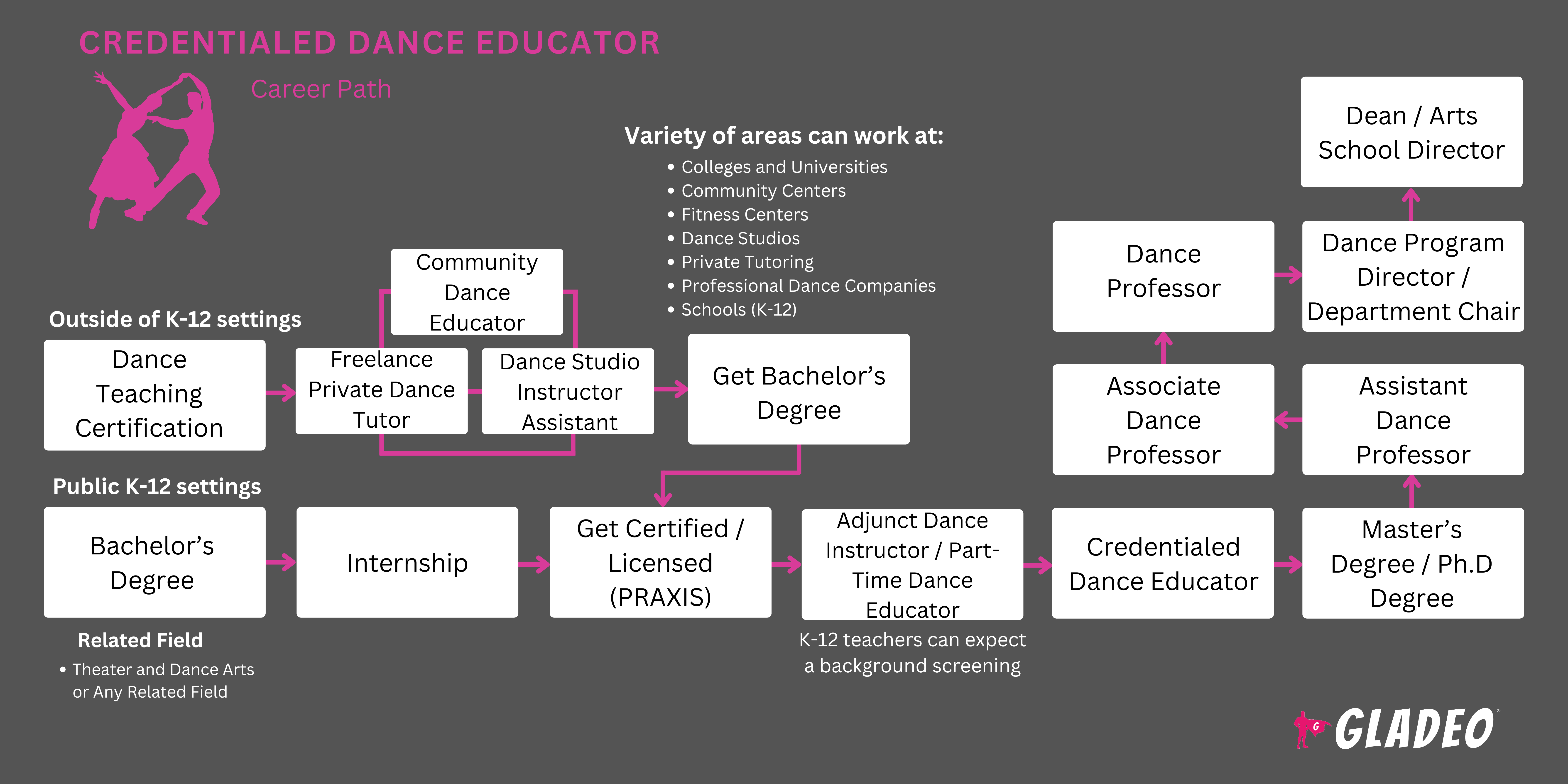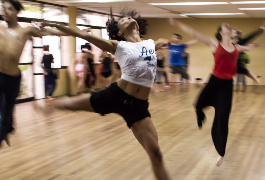Focos
Instructor de danza certificado, educador profesional de danza, profesor de danza acreditado, educador de danza con licencia, instructor de danza cualificado, educador de danza certificado, profesor de danza acreditado, instructor de danza registrado, profesor de danza con licencia, educador de danza acreditado.
Los educadores de danza acreditados suelen ser coreógrafos o bailarines que han alcanzado un alto nivel de destreza en la danza y una amplia experiencia como instructores. Imparten clases en una gran variedad de entornos, incluyendo conservatorios universitarios y escuelas de primaria y secundaria. Algunos trabajan en estudios de danza privados y centros comunitarios como profesores de enriquecimiento personal, impartiendo clases a alumnos que desean aprender diferentes estilos de danza por motivos recreativos, para mantenerse en forma o para prepararse para un evento especial. Algunos educadores actúan como consultores en obras de teatro, películas, conciertos y vídeos musicales.
Ser un educador de danza «acreditado» simplemente significa que la persona ha alcanzado un nivel específico de educación y formación, a diferencia de un instructor de danza no acreditado. Por lo demás, sus misiones son las mismas, es decir, moldear y preparar a la próxima generación de artistas escénicos o ayudar a los estudiantes a alcanzar otros objetivos. Los intérpretes activos más jóvenes pueden dedicarse a la enseñanza como una forma de aumentar sus ingresos mientras avanzan en sus carreras artísticas. Los bailarines que se encuentran en una etapa más avanzada de su carrera pueden considerar la enseñanza como la siguiente fase de su carrera, sintiendo la necesidad de transmitir lo que han aprendido.
A diferencia de materias como las matemáticas o el inglés, la danza implica conceptos y técnicas físicas. Es una forma de arte divertida pero agotadora que requiere pasión y un compromiso con una vida saludable y prácticas seguras para evitar lesiones.
- Compartir la pasión e inspirar a otros
- Trabajar con música emocionante, movimiento y coreografías.
- Crear entornos de aprendizaje positivos en los que los alumnos puedan relajarse y expresarse libremente.
- Mantenerse en buena forma física
- Mostrar el fruto del propio esfuerzo ante el público.
- Ayudar a estudiantes de todas las edades a desarrollar sus talentos o simplemente a divertirse.
- Contribuyendo al mundo más amplio de las artes
Horario de trabajo
- Los educadores de danza acreditados pueden trabajar a tiempo completo o parcial, dependiendo del empleo que elijan. Algunos trabajan en horario escolar habitual; otros pueden trabajar por la noche, por la tarde o los fines de semana.
Funciones típicas
- Crea un plan de estudios atractivo que cubra el alcance de la clase.
- Prepara lecciones diarias con objetivos claros.
- Asegúrese de que el área de práctica esté limpia, sea privada y no presente peligros.
- Instale el equipo de audio u otro equipo, según sea necesario.
- Emplear diferentes métodos de enseñanza para instruir a los alumnos de forma individual y en grupo.
- Enseñar a los alumnos cómo colocarse y moverse correctamente, enseñándoles las técnicas de baile adecuadas para evitar lesiones.
- Enseñar a los alumnos sobre el ritmo y el movimiento interpretativo.
- Adaptar los métodos y materiales para satisfacer las necesidades e intereses individuales.
- Fomenta el desarrollo de los estudiantes exponiéndolos a diferentes estilos.
- Observar y supervisar el rendimiento para determinar las limitaciones y capacidades, y ofrecer orientación para mejorar.
- Evaluar y calificar a los alumnos según sea necesario; ayudar a garantizar que cumplan los objetivos del curso o la formación.
- Preparar y administrar pruebas, cuando corresponda.
Responsabilidades adicionales
- Manténgase en buena forma física para demostrar las técnicas adecuadas, si procede.
- Ten todos los materiales o equipos listos en cantidades suficientes.
- Elige música adecuada para rutinas de baile, incluyendo bailes de salón como el American Smooth, el American Rhythm, el International Standard o el International Latin, así como estilos como el moderno, el hip hop, el jazz, el claqué, el ballet, el folclórico, el irlandés o el swing.
- Investiga nuevos estilos o tendencias musicales y de baile.
- Enseñar buenas prácticas de seguridad y mantener un entorno de aprendizaje seguro.
- Mantener el orden y la disciplina, asegurándose de que los alumnos presten atención y se comporten correctamente en un entorno positivo.
- Completar y conservar los expedientes de los alumnos según lo requiera el empleador.
- Ayudar a los estudiantes que se enfrentan a dificultades o retos de aprendizaje.
- Comparte ideas sobre el plan de estudios con la dirección y el profesorado del centro educativo.
Habilidades sociales
- Agilidad y capacidad atlética
- Deseo y aptitud para ayudar a otros a alcanzar el éxito.
- Disciplina
- Empatía y paciencia
- Entusiasmo
- Flexibilidad
- Gran capacidad de organización
- Seguimiento y evaluación
- Enfoque de enseñanza sin prejuicios
- Persistencia
- Resistencia física
- Sentido del ritmo
- Habilidades para coordinar e instruir actividades
- Fuertes habilidades de comunicación
- La capacidad de supervisar y evaluar el comportamiento de los alumnos.
- Visualización
Habilidades técnicas
- Coreografía
- Familiaridad con diferentes géneros musicales, pasos de baile y rutinas.
- Conocimientos básicos sobre software educativo diseñado para alumnos de primaria y secundaria.
- Primeros auxilios/RCP
- Conocimiento de la anatomía humana
- Conocimientos prácticos sobre sistemas de sonido e iluminación.
- Conocimientos sobre el escenario y la interpretación
- Escuelas autónomas
- Conservatorios universitarios
- Compañías de danza
- Sector del entretenimiento
- Escuelas públicas y privadas de educación primaria y secundaria
- Academias y estudios de danza privados
- Estudios de baile privados
- Empresas propias
- Centros juveniles
Aprender a bailar profesionalmente requiere años de entrenamiento intenso. Es importante ser consciente del riesgo de lesiones que puede derivarse del uso excesivo y tomar las precauciones necesarias para practicar y actuar de forma segura, tanto para uno mismo como para los alumnos.
Es natural que los bailarines que se acercan a los 40 años estén preparados para dedicarse a la enseñanza. Independientemente de lo activos que sean en sus carreras profesionales como bailarines, los educadores de danza siempre deben esforzarse por llevar un estilo de vida saludable. Esto implica una rutina de nutrición y ejercicio adecuados, junto con mucho descanso y recuperación. Por lo tanto, para ser profesor de danza se necesita mucha práctica y entrenamiento «entre bastidores», sin contar el tiempo dedicado a preparar las clases, entrenar y coreografiar rutinas. Se trata de una profesión en la que el amor por el arte y el compromiso con los alumnos compensan el trabajo de preparación y los ensayos y actuaciones fuera de clase.
Basta con decir que este puede ser un trabajo muy ajetreado, en el que se dedica mucho tiempo a tareas preparatorias no remuneradas. Es posible que también tengas que comprometerte a trabajar por las noches y los fines de semana para adaptarte a los horarios específicos de las clases.
En 2019, el 10 % de los bailarines y el 54 % de los coreógrafos desempeñaban algún tipo de función docente. Cada vez más, los bailarines profesionales se están dedicando al emprendimiento, creando sus propias oportunidades de autoempleo. De hecho, muchos aprovechan la tecnología como una forma de monetizar su enseñanza a través de clases y tutoriales de baile virtuales en línea. Sin embargo, ¡los negocios tradicionales también siguen vivos y coleando!
En 2021, hay 56 116 estudios de danza en Estados Unidos, lo que indica que hay un gran potencial para que los bailarines salgan al mercado y enseñen a otros. Esa cifra no incluye las oportunidades de enseñanza en escuelas primarias, secundarias y universidades, que también son populares y pueden ofrecer más beneficios para los empleados.
Como era de esperar, la mayoría de los profesores de danza amaban la música y el movimiento cuando eran más jóvenes. No hay límite en cuanto a los tipos de música que podían disfrutar; a algunos les encantaba escuchar canciones pop y dance mientras veían vídeos y practicaban pasos de baile en sus habitaciones. Otros quizá se apuntaron a clases de ballet a una edad temprana, felices de bailar al son de la música clásica y ofrecer actuaciones improvisadas a sus amigos y familiares. Independientemente del género o estilo musical, lo más probable es que en algún momento les gustara ser el centro de atención y quisieran que los demás disfrutaran de sus esfuerzos.
Los educadores de danza acreditados son personas activas que disfrutan de los esfuerzos físicos. Para ellos, sudar es una forma de sentirse vivos. Es posible que hayan practicado otras formas de ejercicio, como deportes, senderismo, ciclismo, artes marciales o natación. Sin embargo, al final, ¡siempre acababan volviendo a la adictiva combinación de música y danza!
- Un educador de danza acreditado cuenta con formación profesional y certificación.
- Quienes enseñan fuera del ámbito de la educación primaria y secundaria pueden no necesitar una licenciatura, pero sí necesitarán una certificación, así como experiencia laboral suficiente.
- Los colegios comunitarios, las universidades y las escuelas especializadas ofrecen certificados de danza relevantes que pueden ayudarte a cualificarte para puestos de nivel inicial en estudios privados.
- Dance Parent 101 ofrece una lista completa de las escuelas de danza de todo el país.
- Los educadores que trabajan en centros públicos de educación primaria y secundaria pueden necesitar una licenciatura en un campo relevante, como artes escénicas y danza, además de completar un programa de formación docente como parte de su titulación.
- La mayoría de los programas de preparación docente incluyen prácticas para que puedas adquirir experiencia enseñando a alumnos del nivel en el que deseas impartir clases.
- Las prácticas suelen realizarse después de los dos primeros años de universidad.
- Los estudiantes trabajan bajo la supervisión de un profesor cualificado, que realizará observaciones y proporcionará comentarios sobre la eficacia de la enseñanza.
- Si vas a enseñar en un centro de educación primaria y secundaria, necesitarás una licencia o certificación estatal tras graduarte.
- Tenga en cuenta que los requisitos varían según el estado y el tipo de escuela (pública o privada).
- Aquellos que se hayan graduado sin haber realizado un programa de preparación docente (pero que aún lo necesiten para obtener la titulación) pueden solicitar una certificación alternativa. Consulte la Guía de certificación docente alternativa de la Junta Americana para la Certificación de la Excelencia Docente y el Título de Certificación Docente para obtener más detalles.
- La mayoría de los estados exigen que los profesores aprueben un examen Praxis antes de expedir una licencia de enseñanza. Los exámenes pueden incluir un examen de habilidades académicas básicas para educadores.
- Los profesores de primaria y secundaria pueden esperar una verificación de antecedentes que revise sus historiales penales y crediticios.
- Algunos estados o empleadores prefieren que los profesores obtengan un título de máster. Otros requisitos especiales incluyen:
- Concienciación y compromiso con la diversidad y la igualdad en las escuelas.
- Familiaridad con un segundo idioma en algunas escuelas
- Pruebas de habilidades adicionales, si se trabaja con jóvenes con necesidades especiales.
- Para obtener más información, visite:
- Consejo Nacional de Danza de Estados Unidos (NDCA)
- Organizaciones miembros de la NCDA
- Danza/EE. UU.
- Asociación Nacional de Profesores de Danza de Estados Unidos
- Fondo Nacional para las Artes
- Alianza Norteamericana de Organizadores de Danza
- Bailes de salón en EE. UU.
- Algunos estudiantes optan por estudiar en el extranjero. Si esa es una opción para ti, entonces revisa escuelas como la Royal Academy of Dance de Inglaterra.
- Consejo Nacional de Danza de Estados Unidos (NDCA)
- Muchos educadores de danza acreditados obtienen la certificación, pero no necesitan un título universitario para enseñar (en particular aquellos que no enseñan en un sistema escolar de primaria y secundaria).
- Si asistes a una universidad o centro de enseñanza superior, asegúrate de que esté debidamente acreditado.
- La mayoría de los estados no concederán la licencia o certificación docente si tu título no procede de una escuela acreditada regionalmente y de un programa acreditado por el Consejo Nacional para la Acreditación de la Formación Docente (NCATE) o el Consejo para la Acreditación de la Preparación de Educadores (CAEP).
- Compara siempre los costes de matrícula, alojamiento y manutención, y busca en Internet oportunidades de becas y ayudas económicas relevantes. ¡Lo último que quieres es graduarte con una montaña de deudas!
- El baile es, obviamente, un tema muy físico de enseñar, por lo que, para aprender a impartirlo, es recomendable asistir a cursos presenciales siempre que sea posible.
- Si los cursos o programas en línea son más adecuados para tu situación, revísalos cuidadosamente para asegurarte de que tengan una buena reputación y ofrezcan el nivel de credenciales que necesitas.
- Ser profesor de danza es como tener dos trabajos al mismo tiempo: ¡bailarín y profesor! Tendrás que convertirte en un experto en ambos y ser capaz de combinar las habilidades de ambos.
- El baile profesional lleva años dominarlo, así que practica desde temprano y con frecuencia, ¡y toma tantas clases públicas y privadas como puedas!
- También debe desarrollar habilidades interpersonales relacionadas con la comunicación verbal, el liderazgo y la pedagogía docente.
- Ofrecerse como voluntario en su escuela para ayudar con actividades relacionadas con las artes escénicas y los eventos, especialmente aquellas que desarrollan habilidades de liderazgo y gestión de actividades.
- Realiza cursos que te ayuden a prepararte para la enseñanza en el aula en el mundo real, como oratoria, psicología, educación especial y gestión del comportamiento.
- ¡Busca oportunidades remuneradas o voluntarias en las que puedas practicar la gestión y coordinación de un montón de pequeños cuerpos corriendo en diferentes direcciones! Aprende a canalizar y enfocar sus energías en una actuación.
- Aprender y aplicar la diversidad y las normas sociales en todos los entornos educativos.
- Conviértete en una persona segura y accesible con la que los alumnos se sientan cómodos en el entorno de aprendizaje que estás creando para que practiquen sus movimientos.
- Mantente en sintonía con tu cuerpo y no te excedas. Si te exiges demasiado, corres el riesgo de sufrir una lesión permanente que puede arruinar tu carrera como bailarín en un instante.

- Decida lo antes posible qué tipo de baile(s) quiere estudiar y enseñar, y en qué entornos quiere enseñarlos.
- Si vas a enseñar en un centro de educación primaria y secundaria, asegúrate de haber obtenido la licencia o certificación exigida por el estado. Esto puede incluir completar una licenciatura en un campo relevante, terminar un curso preparatorio para profesores, realizar los exámenes Praxis y superar una verificación de antecedentes.
- Si no estás enseñando en un entorno de educación primaria y secundaria, es posible que los empleadores se centren más en tu historial laboral, así que incluye en tu currículum o solicitud detalles actuales y relevantes sobre dónde has trabajado.
- Utiliza datos cuantificables siempre que sea posible, como estadísticas sobre el número de personas ante las que has actuado o el número de clases y alumnos que ya has impartido.
- Considera la posibilidad de crear un portafolio de vídeos online con tus trabajos, ya sea en tu propia página web, en Vimeo o en tu canal de YouTube.
- Mantén un contacto cercano con tu red profesional, que puede avisarte cuando surjan oportunidades y servir como referencia para que los posibles empleadores puedan llamar y hablar sobre ti.
- Busca en portales de empleo estándar como Indeed.com y Glassdoor, pero también revisa detenidamente los sitios web de organizaciones profesionales que puedan tener bolsas de trabajo (consulta nuestra lista de sitios web en la sección Recursos más abajo).
- ¡Prepárate para las entrevistas! Practica realizando algunas entrevistas simuladas con tus amigos.
- Demostrar conocimiento y competencia en relación con las tendencias del aprendizaje electrónico.
- ¡Demuestra tu entusiasmo tanto por el baile como por la enseñanza! Los empleadores quieren saber que te centras en ayudar a sus alumnos y no solo en tu propia carrera profesional.
- ¡Establezca vínculos dentro de la organización en la que trabaja! Conozca al personal, a sus compañeros, a los padres y a los administradores, según corresponda.
- Realiza cursos adicionales de formación y desarrollo profesional. Si tienes una certificación, obtén una más avanzada o haz una licenciatura. Si tienes una licenciatura, ¡haz un máster!
- Demuestra un interés sincero por el progreso de tus alumnos, independientemente de su edad.
- Construye tu reputación como profesor dentro de la comunidad, así como tu reputación como bailarín a nivel estatal o superior.
- Mantén tu sitio web, canal de Vimeo o YouTube actualizados. Aprende a promocionarte y a comercializarte, y aprovecha el poder de las redes sociales para conseguir visitas.
- Imparte talleres fuera de tu zona para ampliar tu presencia a nivel local.
- Ser mentor de otros y ayudarlos a crecer para que se conviertan en futuros profesionales de la danza y, tal vez, también en educadores.
- Participa en actividades de organizaciones profesionales y hazte conocido como experto en un estilo o nicho concreto.
- Mantenga altos los niveles de energía en sus aulas incorporando nuevas ideas y técnicas. Sea consciente de la moral de los alumnos y tome medidas proactivas para garantizar que todos se sientan bienvenidos, seguros e inspirados.
- ¡Lee libros y revistas, mira vídeos o asiste a eventos en directo para estar al día de las últimas tendencias y mantener la motivación!
Sitios web
- Compañía American Ballroom
- Arthur Murray Internacional
- Danza/EE. UU.
- Asociación Internacional de Bailarines Dance Vision
- Fred Astaire Dance Studios Internacional
- Fundación Danza Patrimonial
- Consejo Nacional de Danza de Estados Unidos (NDCA)
- Asociación Nacional de Profesores de Danza de Estados Unidos
- Fondo Nacional para las Artes
- Organizaciones miembros de la NCDA
- Alianza Norteamericana de Organizadores de Danza
- Asociación Norteamericana de Profesores de Baile Deportivo
- Profesores Panamericanos de Danza
- Federación de Bailarines Profesionales
- Bailes de salón en EE. UU.
- Sociedad Imperial de Profesores de Danza de Estados Unidos
- Asociación Terpsichore de EE. UU.
- Federación Mundial de Bailarines de Salón
Libros
- La agenda definitiva para el negocio de la danza: agenda empresarial de 12 meses para escuelas de danza, por Deborah Laws.
- Pedagogía de la danza para un mundo diverso: enseñanza culturalmente relevante en la teoría, la investigación y la práctica, por Nyama McCarthy-Brown.
- Cómo enseñar ballet para principiantes: los tres primeros años, por Judith Newman.
- Clase de danza jazz: desde principiantes hasta avanzados, por Gus Giordano.
El camino para convertirse en un educador de danza acreditado puede ser largo y arduo, pero vale la pena para aquellos que no pueden imaginar hacer otra cosa en sus vidas. Pero si puedes imaginar hacer otra cosa y quieres explorar alternativas, echa un vistazo a las ocupaciones relacionadas con el sector del entretenimiento que ofrece la Oficina de Estadísticas Laborales:
- Actores
- Directores artísticos
- Directores musicales y compositores
- Músicos y cantantes
- Profesores de educación superior
- Productores y directores
Si te interesa más la enseñanza, algunas opciones profesionales viables son:
- Profesores de inglés como segunda lengua
- Profesores de carrera
- Directores de escuela
- Profesores de educación primaria y secundaria
- Orientadores escolares y profesionales
- Profesores de educación especial
Fuente de noticias

Empleos destacados

Cursos y herramientas en línea

Expectativas salariales anuales
Los nuevos trabajadores comienzan con un salario de alrededor de 38 000 dólares. El salario medio es de 61 000 dólares al año. Los trabajadores con mucha experiencia pueden ganar alrededor de 81 000 dólares.
Expectativas salariales anuales
Los nuevos trabajadores comienzan con un salario de alrededor de 48 000 dólares. El salario medio es de 67 000 dólares al año. Los trabajadores con mucha experiencia pueden ganar alrededor de 98 000 dólares.
Expectativas salariales anuales
Los nuevos trabajadores comienzan con un salario de alrededor de 38 000 dólares. El salario medio es de 56 000 dólares al año. Los trabajadores con mucha experiencia pueden ganar alrededor de 76 000 dólares.
Expectativas salariales anuales
Los nuevos trabajadores comienzan con un salario de alrededor de 38 000 dólares. El salario medio es de 62 000 dólares al año. Los trabajadores con mucha experiencia pueden ganar alrededor de 78 000 dólares.
Expectativas salariales anuales
Los nuevos trabajadores comienzan con un salario de alrededor de 35 000 dólares. El salario medio es de 47 000 dólares al año. Los trabajadores con mucha experiencia pueden ganar alrededor de 75 000 dólares.








